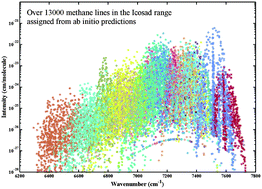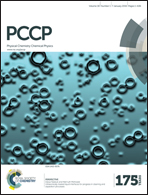Ab initio variational predictions for understanding highly congested spectra: rovibrational assignment of 108 new methane sub-bands in the icosad range (6280–7800 cm−1)†
Abstract
A detailed study of methane spectra in the highly congested icosad range of 6280–7800 cm−1 has been performed using global variational calculations derived from accurate ab initio potential energy and dipole moment surfaces. About 13 000 12CH4 lines of the WKLMC line lists recorded at 80 and 296 K using very sensitive laser techniques (DAS, CRDS) have been rovibrationally assigned from first principles predictions. Overall, a total of 7436 upper energy levels were determined. Among the 20 bands and the 134 sub-levels contained in the icosad system, 20 and 108 have been identified for the first time, respectively. The assigned transitions represent 98% of the sum of the experimental intensity at 80 K. This work demonstrates for the first time how accurate first principles global calculations allow assigning complicated spectra of a molecule with more than 4 atoms.


 Please wait while we load your content...
Please wait while we load your content...